
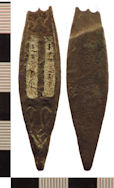
Within the first five years of fieldwork at Cottam B the two concentrations of finds were identified and the spatial differentiation of artefacts of differing date allowed the origins of the site to be associated with the southern area, and its demise with the northern area (Haldenby 1992). It was also deduced that the four disc-headed pins found up to that point were likely to be later types since they were all found in the north. Furthermore, the fact that most strap-end types (namely Thomas Class A (Thomas 2003), which account for over 60% of Anglian and Anglo-Scandinavian strap-ends), are found in the north was felt to be evidence for the development of these strap-ends largely in the 9th century. The restricted range of decoration - mainly ring-and-dot - on what were previously described as 'simple’ pins (now termed 'collared’) originally allowed only a broad 8th/9th-century dating.
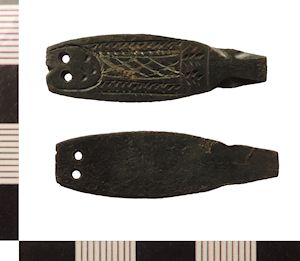
A number of observations about the typology of the strap-ends were offered in the excavation report (Richards 1999a, 12-15). At that stage strap-ends with silver wire inlay (Figure 14) and those with geometric design (Figure 15) mostly came from the south and it was proposed that these were likely to be early types; with larger numbers of finds this no longer seems to be the case. In contrast, the recovery of two strap-ends with multiple animal head decoration (Figures 16-17) from the northern area was believed to support a previous suggestion that these are Anglo-Scandinavian (Haldenby 1998), made on the basis of close decorative parallels with a strap-end from the Viking grave at Knock y Doonee on the Isle of Man, and a strap-distributor from Västergötland in Sweden (Bersu and Wilson 1966, plate 18c). The subsequent recognition of another example from the northern area (Figure 18) gives additional support to this dating.
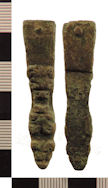
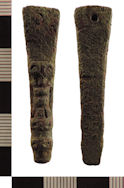
A decade later the much expanded pin corpus was partially categorised according to the following three groups: faceted; biconical together with globular; and discs (Figure 19) (Haldenby and Richards 2009). Proportions of these were calculated for the two concentrations, along with three other 9th-century Anglian sites in the region which, in common with the southern area at Cottam, showed little evidence of Anglo-Scandinavian occupation. In the northern area the relatively low proportions of faceted pins observed was felt to indicate that these went out of use at the start of the Anglo-Scandinavian era, replaced by pins with disc-heads, on the basis of their presence as a relatively high proportion. A globular-headed form with rising curved faces was also felt to be a late contemporary of the disc-headed pins since the three examples then known all came from the northern area.
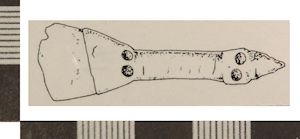
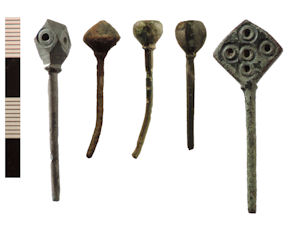
The pin classification was subsequently developed independently, taking into account additional pin finds (Haldenby 2012). This involved the separation of the biconical type from globular-headed forms, which can be readily distinguished unless they are poorly formed, worn through use, or subsequently corroded. Classification is also aided by the observation that, on average, globular forms have head diameters 10-15% smaller than biconical forms. As part of this further work on pins the term 'collared’ was proposed for all 9th-century pins, describing the feature usually found directly beneath the head, and largely absent from earlier 8th-century and later 10th-century forms. Other new terms were also introduced (Haldenby 2012), principally 'polyhedral’ replaced 'facets’ and 'plate’ took the place of 'disc’ since, although the latter are all flat, they do vary in shape. All of the main 'collared’ pin types have now been categorised and their respective proportions in the northern area, where the Anglian and Anglo-Scandinavian assemblages are now recognised as being mixed together, have been compared with those from the southern area and other 9th-century Anglian comparator sites (Figure 20).
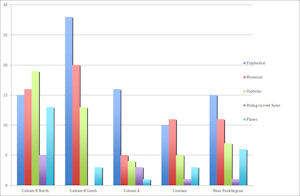
In the northern area not only is the previously recognised decline in polyhedral pins still apparent but also that in the biconical forms, each supplanted by: plate heads (now thirteen); those with rising curved faces (now five); and a continuation of globular forms during the transition to the Anglo-Scandinavian period. Therefore, the conclusions reached about the chronology of these pins in 2009 still hold good despite the substantial growth in Anglian finds from the northern area indicating that the assemblage from there can no longer be seen as representing a small number of Anglian finds acquired and transported to the site by the Vikings.
Dating of collared pins more narrowly than the 8th/9th centuries had not previously been demonstrated. However, a largely 9th-century date was proposed for these pins (Haldenby 2012) on the basis of a number of factors. Firstly, they are distinct from both 8th-century and 10th-century pin forms in terms of the eponymous collar commonly seen beneath a small range of specific head forms of reduced size along with plainer, ungilded decoration; secondly, they are abundant on Anglian sites across Northumbria in similar proportions to stycas and strap-ends, suggesting a shared chronology; and finally, 8th-century pins, but not collared pins or strap-ends, are present at Shakenoak (Oxfordshire), which terminates before the end of the 8th century (Brodribb et al. 1973). At Cottam the presence of the full range of collared pin types on the post-800 northern area provides further support for this 9th-century dating.
Internet Archaeology is an open access journal based in the Department of Archaeology, University of York. Except where otherwise noted, content from this work may be used under the terms of the Creative Commons Attribution 3.0 (CC BY) Unported licence, which permits unrestricted use, distribution, and reproduction in any medium, provided that attribution to the author(s), the title of the work, the Internet Archaeology journal and the relevant URL/DOI are given.
Terms and Conditions | Legal Statements | Privacy Policy | Cookies Policy | Citing Internet Archaeology
Internet Archaeology content is preserved for the long term with the Archaeology Data Service. Help sustain and support open access publication by donating to our Open Access Archaeology Fund.